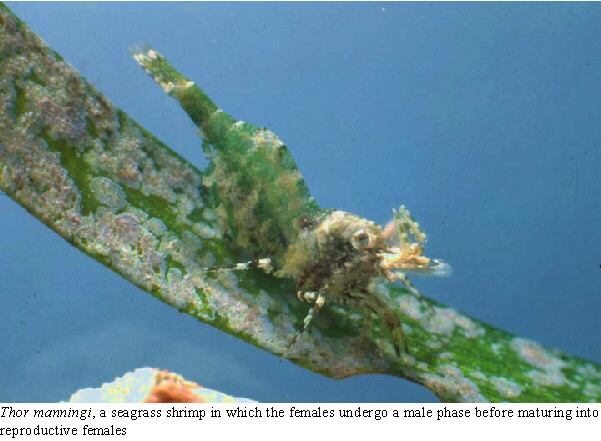

Although most species of caridean shrimps have separate sexes, a fair number are "sequential hermaphrodites" in which an individual is first one sex and then changes to the other at some later stage of life. Individuals are first male, then female (protandry). There are several variations on this theme. A study on Thor manningi, shown above, from tropical seagrass meadows, stimulated by earlier observations by Dr. F.A. Chace, Jr. from the Smithsonian Institution, showed protandry with a "twist." In this species, half the population are protandric, first male and then female. The other half are "primary males," i.e., individuals which do not change sex and do not grow as large as the hermaphroditic "females." Furthermore, these males are "supermales" with enlarged male genitalia and a grasping leg that male-phase hermaphrodites do not have. I have made but not yet tested the hypothesis that these "supermales" are superior in mating ability and thus have not been eliminated by natural selection as have the primary males of other protandric species. Interestingly, two other species of Thor from similar seagrass habitats are not all protandric, showing that understanding of this system and other protandric carideans is far from complete (see Bauer, 1986; Bauer and VanHoy, 1996).
Supported by the NATIONAL SCIENCE FOUNDATION:
A recent exciting discovery is simultaneous
hermaphroditism in shrimps of the genus Lysmata,
unknown
in other decapod crustaceans (shrimps, crabs, lobsters). In
Lysmata
wurdemanni, the peppermint or red cleaner shrimp of the Gulf of Mexico
(above), individuals begin life as males, and, as in protandric species,
many individuals change with increasing age and larger size to "females"
(Bauer & Holt, 1998) (see also short photo piece in National Geographic
magazine, March 2000 issue in "Earth Almanac"). However, these "females"
retain their male reproductive ducts and testes which produce sperm. Time-lapse
video observations show that these "females" (actually true simultaneous
hermaphrodites), even those carrying incubated embryos, can mate as males
with and fertilize other such "females" which are ready to spawn a new
brood. Observations on isolated "female" hermaphrodites show that they
cannot fertilize themselves. Simultaneous hermaphroditism has also
been shown in Lysmata amboinensis
(Fiedler, 1998, Pacific Science
52: 161-169) and L. californica (Bauer and Newman, 2004), and is
likely in L. grabhami as well (observations in Wirtz, 1997,
J. Zool. 242: 799-811). The social system and mating system of
Lysmata
species, as well as their ancestor-descendant relationships, are being
studied, with funding from the National Science Foundation (Grant #9982466),
in order to determine how this sexual system has evolved (and why, like
protandry, it has not evolved more frequently) (see Bauer, 2000, 2001,
2002a,b; Baldwin and Bauer, 2003; Baeza and Bauer, 2004)). (Any opinions,
findings, and conclusions or recommendations expressed in this material
are those of the author(s) and do not necessarily reflect the views of
the National Science Foundation.). See Bauer (2006) for a synthesis
to date of this work.
Back to Home Page.